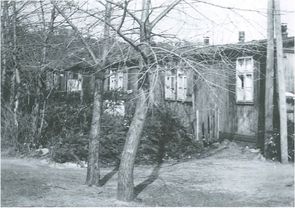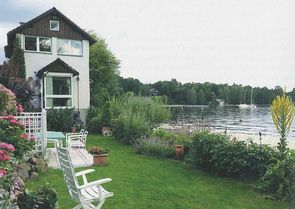Summer 1945
Schwanenwerder: Familie Schertz
"The barracks camp was highly polluted, full of rats, and the rooms themselves were badly bugged. The room for three people assigned to us was about three by four meters... The first days and weeks were spent on bug control... Of course, it also became clear to us under what conditions the 'foreign workers', as they had been called in previous years, were housed."
(Memories of Georg Schertz, Schwanenwerder Island resident)
Georg Schertz is 10 years old when the fighting for the Reich capital reaches the districts of Wannsee and Zehlendorf on 25 April 1945. The Schertz family lives in a house at Inselstraße 2 on the island of Schwanenwerder, which is occupied by Soviet units shortly afterwards. At the beginning of June American units move in on the island to take over the administration in the future western sectors. The Villa Baginski at Inselstraße 16 is selected and confiscated as quarters for the supreme commander of the US forces. Shortly afterwards, American authorities hand out questionnaires to the German islanders, which have to be filled out immediately. "The aim was to put all German residents to the test to see whether they could pose a danger to General Eisenhower." recalls Georg Schertz. In the following days, the authorities invite the residents for questioning. About ten of them are ordered to leave the island immediately. The Schertz family receives permission to stay for the time being.
On the morning of August 7, 1945 the doorbell of the family home rings and the 10-year-old opens the door for an American soldier. The father hurries over and receives the interpreter's dry order: "You are to leave the house by 9:30 pm today. You understand?"
Together with the Schertz family, the other Berlin residents of Schwanenwerder are now also ordered to leave the island. The departure is secured militarily. Georg's parents pack together something they can grab in the short time available. At first it is unclear where the family should go. "The Americans didn't care either," Georg Schertz recalls. "From their point of view, it was a German matter."
So the former forced camp across from the Wannsee Terrace becomes the Schertz family's new "home". The camp had been built during the Nazi era to house civilian forced labourers, prisoners of war and concentration camp inmates. Together with other Berliners, they share a wooden barrack, one room per family measuring about three by four meters. The barracks are dirty and infested with pests. To enter their room, the Schertz family has to cross the adjoining room that had been assigned to another family. "Through all this, my parents somehow managed to cope with the situation. I cannot associate the months we spent there with memories of having suffered greatly," Schertz later reports. The grammar school student made his way to school in Zehlendorf in the fall of 1945 on foot through the forest and then by S-Bahn from the Nikolassee S-Bahn station. Schertz remembers: "Once or twice I managed to get into our house on the island after all, pretending to take out a toy. In reality, however, to bring a document under my clothes, which my father urgently needed."
When the Americans left the island in April 1946, the family returned to Schwanenwerder. The news that the Americans had left the island had already been rumoured several times before. "We found the house completely open and thus accessible to everyone," reports Georg Schertz. "Inside it looked terrible. All our household goods were broken, trampled, dirty." But this time the family can actually stay. "We were home again, nothing was more important." And Schertz goes on to say, "For all that, I don't want to be misunderstood, it was as described, but it was just the time of the 'victors' over a Nazi Germany that had started a criminal war and brought great misfortune to many peoples and people."
(Source: Georg Schertz, "Memories of the end of the war and the early post-war years in Berlin," in: Yearbook of the Berlin State Archive, ed. Werner Breuning and Uwe Schaper, Berlin: Gebr. Mann Verlag, 2018)

